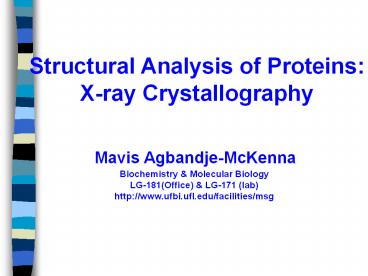Structural Analysis of Proteins: PowerPoint PPT Presentation
1 / 31
Title: Structural Analysis of Proteins:
1
Structural Analysis of Proteins X-ray
Crystallography
Mavis Agbandje-McKenna
Biochemistry Molecular Biology LG-181(Office)
LG-171 (lab) http//www.ufbi.ufl.edu/facilities/ms
g
2
Biochemistry
Molecular Biology
3D STRUCTURE
Pathology
Genetics
Proteomics
Immunology
Virology
Structure-Function Analysis
3
Structure Analysis Techniques
- Nuclear Magnetic Resonance 20-30kD proteins
- X-ray Crystallography Any protein that can be
crystallized - Electron Microscopy Viruses Macromolecul
ar assemblages Membrane proteins
4
Advances in X-ray Structural analysis
Penicillin (18 atoms, Hodgkin 1949) Myoglobin
(1260 atoms, Kendrew,1955) 10,000th protein
structure in the Protein Data Base Assembly
intermediate of bacteriophage FX174
(500,000 atoms, 420 protein molecules, 1998)
5
Strategy for Structural Analysis of Proteins
Protein Expression Purification Protein
Crystallization Diffraction Data Collection -
Amplitudes Space Group Determination - Packing
of Molecules Structure Solution - Phasing
(different methods) Electron Density Map
Interpretation - Model Building Structural
Refinement - Validation Structural Analysis -
Biological Implications
Specialized Computer packages are required
6
The Crystallization Experiment
Crystal Screen Kit
Hanging drop
Growth Techniques 1- Hanging Drop 2- Sitting
Drop 3- Sandwich Drop 4- Free interface diffusion
(NASA) 5- Batch (Robots) 6- Microbatch - under
oil. 7- Mcrodialysis (Buttons)
Micro-bridges (Sitting drop)
Virus Crystal 0.15mm
Dialysis Buttons
7
The Diffraction Experiment
Image on Detector
Image on Detector
1. Collimated 1 X-ray beam 2. Crystal 3.
Detector
0.3 oscilation diffraction image of Minute
virus of mice crystals
8
Cryo-Crystallography
Cryo Stream
D
Beam
Goniometer with Mounted Crystal
Liquid Nitrogen
9
X-ray Generator
Rotating Anode X-ray Generator - Target is Cu,
l1.54
10
X-ray Detector
Image Plate system - Photostimulable phosphor
powder
11
X-ray Diffraction Spot Wave
Amplitude - ?Intensity of measured spot (size
of wave) Wavelength - X-ray source
monochromatic radiation Phase - Position with
respect to origin of coordinate system -Lost
during data collection Need all parameters to
mathematically calculate electron density map
to locate the position of the atoms in the
protein.
12
Strategies for Phase Determination Heavy Atom
Soak Method (SIR, MIR) Exploits the ability to
identify the position of electron dense atoms
attached to specific amino acids - e.g. Hg to
Cys Selenium-Methionine Substitution
(MAD) Exploits the anomalous scattering
properties of electron dense atoms. Met are
substituted by Se-Met in proteins. Halide
Cryosoaking (MIR, SIR, MAD or SAD) NEW Diffusion
of bromide or iodide into protein crystals prior
to freezing. Molecular Replacement Approximate
phase information based on a known homologous
structure
13
2.0Å 1.5Å 1.2Å
Resolution Seeing is believing 20 structures
in database with atomic resolution ( 1 Å or
better)
14
European Synchrotron Radiation Facility
15
Levels of Protein Structure
Hemoglobin
Can identify different motifs in protein
structure - Tertiary Level
16
Structure of Human Carbonic Anhydrase II
Database 150 structures best resolution 1.5Å
McKenna Lab -Improve Resolution -Map Proton
transfer Pathway -Look at rescue of
defective enzymes
17
- Carbonic anhydrase catalyzes the reversible
hydration reaction - of carbon dioxide (CO2) to form
bicarbonate (HCO3-) - The first stage is the conversion of
CO2 into bicarbonate by - reaction with the zinc-bound
hydroxide the dissociation - of bicarbonate leaves a water molecule
bound to the zinc
H2O
CO2 EZnOH- EZnHCO3- EZnH2O
HCO3-
18
The second stage of the reaction involves an
intramolecular H transfer to His-64 and a
subsequent intermolecular H transfer out to
bulk solvent which regenerates the Zn-OH- form
of the enzyme
His64-EZnH2O B
HHis64-EZnOH- B
His64-EZnOH- BH
19
Data now available to 0.9Å
20
(No Transcript)
21
(No Transcript)
22
Active site HCA II H64A
H94
H96
Zn2
W1
H119
T199
23
Binding site of 4-MI in HCA II H64A
W 5
H64 in
4-MI
A64
H64 out
24
HCA II H64A Proton Transfer Wire at 1.2 Å
Resolution
(Activator)
(Mutant)
25
Minute Virus of Mice
26
Minute Virus of Mice VP2 - 3.25 Å Resolution
Loop 2
Loop 4
Loop 1
NH2
Loop 3
COOH
27
MVMi
MVMp
28
MVMp-Sialic Acid Complex
S460 (A)
Y558 (H)
317 T/A
D399 (G/A)
2
321 G/E
SA Model
D553 (N)
362 I/V
Virulent MVMp mutant I362S
29
MVMi DNA 30 of Genome
30
(No Transcript)
31
Summary
- Successful analysis requires excellent
multidisciplinary backup. - Structure determinations will become increasingly
automated - robots hardware and software
improvements. - Future of X-ray structure analysis?
Crystallographers? Molecular Biologists? - Proteomics will ensure massive efforts in 3D
structure determination - comparable to human
genome project.

